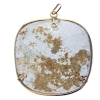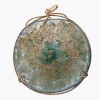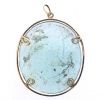|
Ancient Jewelry
|
|
 |
|
 |
|

Price :
$1600.00
Origin: Lebanon (Byblos) Circa: 600 BC to 400 BC Collection: Classical Antiquities Style: Phoenician Medium: Glass, Gold
Origin: Lebanon (Byblos) Circa: 600 BC to 400 BC Collection: Classical Antiquities Style: Phoenician Medium: Glass, Gold « Less
|
|
Ancient Jewelry
|
|
|
|
|
| Vendor Details |
Close |
| Contact Info : |
| Barakat Gallery |
| 405 North Rodeo Drive |
| Beverly Hills |
| California-90210 |
| USA |
| Email : barakat@barakatgallery.com |
| Phone : 310.859.8408 |
|
|
|
|
|
|

Price :
$3300.00
The Ancient Egyptians believed the wedjat eye was the most powerful protection against evil. Ever-vigilant against bad luck and misfortune, the symbolic eye of the god Horus More »
The Ancient Egyptians believed the wedjat eye was the most powerful protection against evil. Ever-vigilant against bad luck and misfortune, the symbolic eye of the god Horus was worn by king and peasant alike. Though the eye was sometimes fashioned in gold and precious stones, it was thought to be at its most powerful when colored blue. The tradition of blue amulets guarding against harm is a very ancient one. Throughout the Mediterranean world today, one sees beads and talismans of bright blue, which are meant to avert the evil eye of bad luck. In Egypt, peasants dip the palm of their hands in blue paint and press their palms against the sides of their houses. When the Egyptian Empire was at its glorious height, this faience eye of the god Horus was worn by some long-forgotten person to bring good fortune and luck. Much has changed in the world since then, but the power of this talisman remains strong and benevolent as always. Whoever wears it today in its golden frame will surely benefit from its ancient magic as well. - (FJ.6890c) « Less
|
|
Ancient Jewelry
|
|
|
|
|
| Vendor Details |
Close |
| Contact Info : |
| Barakat Gallery |
| 405 North Rodeo Drive |
| Beverly Hills |
| California-90210 |
| USA |
| Email : barakat@barakatgallery.com |
| Phone : 310.859.8408 |
|
|
|
|
|
|

Price :
$3300.00
The Ancient Egyptians believed the wedjat eye was the most powerful protection against evil. Ever-vigilant against bad luck and misfortune, the symbolic eye of the god Horus More »
The Ancient Egyptians believed the wedjat eye was the most powerful protection against evil. Ever-vigilant against bad luck and misfortune, the symbolic eye of the god Horus was worn by king and peasant alike. Though the eye was sometimes fashioned in gold and precious stones, it was thought to be at its most powerful when colored blue. The tradition of blue amulets guarding against harm is a very ancient one. Throughout the Mediterranean world today, one sees beads and talismans of bright blue, which are meant to avert the evil eye of bad luck. In Egypt, peasants dip the palm of their hands in blue paint and press their palms against the sides of their houses. When the Egyptian Empire was at its glorious height, this faience eye of the god Horus was worn by some long-forgotten person to bring good fortune and luck. Much has changed in the world since then, but the power of this talisman remains strong and benevolent as always. Whoever wears it today in its golden frame will surely benefit from its ancient magic as well. - (FJ.6890d)a « Less
|
|
Ancient Jewelry
|
|
|
|
|
| Vendor Details |
Close |
| Contact Info : |
| Barakat Gallery |
| 405 North Rodeo Drive |
| Beverly Hills |
| California-90210 |
| USA |
| Email : barakat@barakatgallery.com |
| Phone : 310.859.8408 |
|
|
|
|
|
|

Price :
$460.00
Of all the technological achievements of civilization, perhaps none so delights the senses as glass. For thousands of years, glass has been used to create jewelry, works of More »
Of all the technological achievements of civilization, perhaps none so delights the senses as glass. For thousands of years, glass has been used to create jewelry, works of art, and functional objects of great beauty. In the bible, the value of glass is equated with that of gold and silver, and it was indeed treated by the ancients as a precious substance. The origins of glass are lost in the mists of time, but the Egyptians in the 4th millennium B.C most probably invented it. The roman naturalist Pliny attributes the discovery of glassmaking to the Phoenicians, and the cities of the Levant were famous as centers for the glass trade. The earliest glass was opaque, colored in a variety of rich hues that often imitated gems like lapis and emerald. The Egyptians used it extensively in jewelry and made little distinction between the genuine and the artificial gems. The art of glassblowing and the development of transparent glass both date to the roman period. From centers like Tyre and Alexandria, glass vessels were exported throughout the empire and as Far East as Persia and china. The Romans colored their glass in myriad shades, favoring blue, green and yellow, as well as clear. One of the most fascinating properties of glass is that, through oxidization, it acquires a rich iridescent patina with age. Brilliant as a peacock's tail, this glass pendant is a piece of history, one that appeals directly to the contemporary eye. - (FJ.3588) « Less
|
|
Ancient Jewelry
|
|
|
|
|
| Vendor Details |
Close |
| Contact Info : |
| Barakat Gallery |
| 405 North Rodeo Drive |
| Beverly Hills |
| California-90210 |
| USA |
| Email : barakat@barakatgallery.com |
| Phone : 310.859.8408 |
|
|
|
|
|
|

Price :
$3300.00
he Ancient Egyptians believed the wedjat eye was the most powerful protection against evil. Ever-vigilant against bad luck and misfortune, the symbolic eye of the god Horus More »
he Ancient Egyptians believed the wedjat eye was the most powerful protection against evil. Ever-vigilant against bad luck and misfortune, the symbolic eye of the god Horus was worn by king and peasant alike. Though the eye was sometimes fashioned in gold and precious stones, it was thought to be at its most powerful when colored blue. The tradition of blue amulets guarding against harm is a very ancient one. Throughout the Mediterranean world today, one sees beads and talismans of bright blue, which are meant to avert the evil eye of bad luck. In Egypt, peasants dip the palm of their hands in blue paint and press their palms against the sides of their houses. When the Egyptian Empire was at its glorious height, this faience eye of the god Horus was worn by some long-forgotten person to bring good fortune and luck. Much has changed in the world since then, but the power of this talisman remains strong and benevolent as always. Whoever wears it today in its golden frame will surely benefit from its ancient magic as well. - (FJ.6890e) « Less
|
|
Ancient Jewelry
|
|
|
|
|
| Vendor Details |
Close |
| Contact Info : |
| Barakat Gallery |
| 405 North Rodeo Drive |
| Beverly Hills |
| California-90210 |
| USA |
| Email : barakat@barakatgallery.com |
| Phone : 310.859.8408 |
|
|
|
|
|
|

Price :
$4300.00
The Ancient Egyptians believed the wedjat eye was the most powerful protection against evil. Ever-vigilant against bad luck and misfortune, the symbolic eye of the god Horus More »
The Ancient Egyptians believed the wedjat eye was the most powerful protection against evil. Ever-vigilant against bad luck and misfortune, the symbolic eye of the god Horus was worn by king and peasant alike. Though the eye was sometimes fashioned in gold and precious stones, it was thought to be at its most powerful when colored blue. The tradition of blue amulets guarding against harm is a very ancient one. Throughout the Mediterranean world today, one sees beads and talismans of bright blue, which are meant to avert the evil eye of bad luck. In Egypt, peasants dip the palm of their hands in blue paint and press their palms against the sides of their houses. When the Egyptian Empire was at its glorious height, this faience eye of the god Horus was worn by some long-forgotten person to bring good fortune and luck. Much has changed in the world since then, but the power of this talisman remains strong and benevolent as always. Whoever wears it today in its golden frame will surely benefit from its ancient magic as well. - (FJ.6890F) « Less
|
|
Ancient Jewelry
|
|
|
|
|
| Vendor Details |
Close |
| Contact Info : |
| Barakat Gallery |
| 405 North Rodeo Drive |
| Beverly Hills |
| California-90210 |
| USA |
| Email : barakat@barakatgallery.com |
| Phone : 310.859.8408 |
|
|
|
|
|
|

Price :
$2800.00
The Ancient Egyptians believed the wedjat eye was the most powerful protection against evil. Ever-vigilant against bad luck and misfortune, the symbolic eye of the god Horus More »
The Ancient Egyptians believed the wedjat eye was the most powerful protection against evil. Ever-vigilant against bad luck and misfortune, the symbolic eye of the god Horus was worn by king and peasant alike. Though the eye was sometimes fashioned in gold and precious stones, it was thought to be at its most powerful when colored blue. The tradition of blue amulets guarding against harm is a very ancient one. Throughout the Mediterranean world today, one sees beads and talismans of bright blue, which are meant to avert the evil eye of bad luck. In Egypt, peasants dip the palm of their hands in blue paint and press their palms against the sides of their houses. When the Egyptian Empire was at its glorious height, this faience eye of the god Horus was worn by some long-forgotten person to bring good fortune and luck. Much has changed in the world since then, but the power of this talisman remains strong and benevolent as always. Whoever wears it today in its golden frame will surely benefit from its ancient magic as well. - (FJ.6890Z) « Less
|
|
Ancient Jewelry
|
|
|
|
|
| Vendor Details |
Close |
| Contact Info : |
| Barakat Gallery |
| 405 North Rodeo Drive |
| Beverly Hills |
| California-90210 |
| USA |
| Email : barakat@barakatgallery.com |
| Phone : 310.859.8408 |
|
|
|
|
|
|

Price :
$720.00
Of all the technological achievements of civilization, perhaps none so delights the senses as glass. For thousands of years, glass has been used to create jewelry, works of More »
Of all the technological achievements of civilization, perhaps none so delights the senses as glass. For thousands of years, glass has been used to create jewelry, works of art, and functional objects of great beauty. In the bible, the value of glass is equated with that of gold and silver, and it was indeed treated by the ancients as a precious substance. The origins of glass are lost in the mists of time, but the Egyptians in the 4th millennium B.C most probably invented it. The roman naturalist Pliny attributes the discovery of glassmaking to the Phoenicians, and the cities of the Levant were famous as centers for the glass trade. The earliest glass was opaque, colored in a variety of rich hues that often imitated gems like lapis and emerald. The Egyptians used it extensively in jewelry and made little distinction between the genuine and the artificial gems. The art of glassblowing and the development of transparent glass both date to the roman period. From centers like Tyre and Alexandria, glass vessels were exported throughout the empire and as Far East as Persia and china. The Romans colored their glass in myriad shades, favoring blue, green and yellow, as well as clear. One of the most fascinating properties of glass is that, through oxidization, it acquires a rich iridescent patina with age. Brilliant as a peacock's tail, this glass pendant is a piece of history, one that appeals directly to the contemporary eye. - (FJ.3590) « Less
|
|
Ancient Jewelry
|
|
|
|
|
| Vendor Details |
Close |
| Contact Info : |
| Barakat Gallery |
| 405 North Rodeo Drive |
| Beverly Hills |
| California-90210 |
| USA |
| Email : barakat@barakatgallery.com |
| Phone : 310.859.8408 |
|
|
|
|
|
|

Price :
$3000.00
The Ancient Egyptians believed the wedjat eye was the most powerful protection against evil. Ever-vigilant against bad luck and misfortune, the symbolic eye of the god Horus More »
The Ancient Egyptians believed the wedjat eye was the most powerful protection against evil. Ever-vigilant against bad luck and misfortune, the symbolic eye of the god Horus was worn by king and peasant alike. Though the eye was sometimes fashioned in gold and precious stones, it was thought to be at its most powerful when colored blue. The tradition of blue amulets guarding against harm is a very ancient one. Throughout the Mediterranean world today, one sees beads and talismans of bright blue, which are meant to avert the evil eye of bad luck. In Egypt, peasants dip the palm of their hands in blue paint and press their palms against the sides of their houses. When the Egyptian Empire was at its glorious height, this faience eye of the god Horus was worn by some long-forgotten person to bring good fortune and luck. Much has changed in the world since then, but the power of this talisman remains strong and benevolent as always. Whoever wears it today in its golden frame will surely benefit from its ancient magic as well. - (FJ.6890Y) « Less
|
|
Ancient Jewelry
|
|
|
|
|
| Vendor Details |
Close |
| Contact Info : |
| Barakat Gallery |
| 405 North Rodeo Drive |
| Beverly Hills |
| California-90210 |
| USA |
| Email : barakat@barakatgallery.com |
| Phone : 310.859.8408 |
|
|
|
|
|
|

Price :
$560.00
Of all the technological achievements of civilization, perhaps none so delights the senses as glass. For thousands of years, glass has been used to create jewelry, works of More »
Of all the technological achievements of civilization, perhaps none so delights the senses as glass. For thousands of years, glass has been used to create jewelry, works of art, and functional objects of great beauty. In the bible, the value of glass is equated with that of gold and silver, and it was indeed treated by the ancients as a precious substance. The origins of glass are lost in the mists of time, but the Egyptians in the 4th millennium B.C most probably invented it. The roman naturalist Pliny attributes the discovery of glassmaking to the Phoenicians, and the cities of the Levant were famous as centers for the glass trade. The earliest glass was opaque, colored in a variety of rich hues that often imitated gems like lapis and emerald. The Egyptians used it extensively in jewelry and made little distinction between the genuine and the artificial gems. The art of glassblowing and the development of transparent glass both date to the roman period. From centers like Tyre and Alexandria, glass vessels were exported throughout the empire and as Far East as Persia and china. The Romans colored their glass in myriad shades, favoring blue, green and yellow, as well as clear. One of the most fascinating properties of glass is that, through oxidization, it acquires a rich iridescent patina with age. Brilliant as a peacock's tail, this glass pendant is a piece of history, one that appeals directly to the contemporary eye. - (FJ.3592) « Less
|
|
Ancient Jewelry
|
|
|
|
|
| Vendor Details |
Close |
| Contact Info : |
| Barakat Gallery |
| 405 North Rodeo Drive |
| Beverly Hills |
| California-90210 |
| USA |
| Email : barakat@barakatgallery.com |
| Phone : 310.859.8408 |
|
|
|
|
|
|
|
|

|


